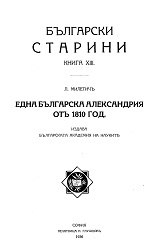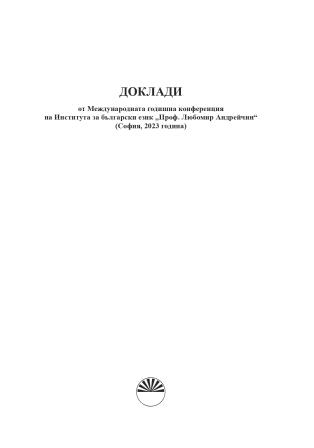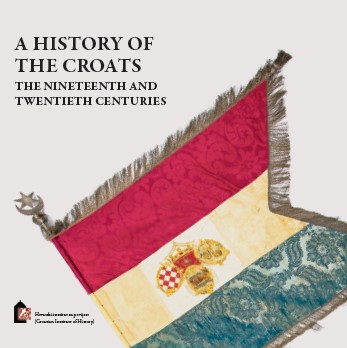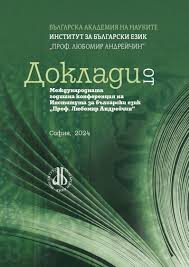
ЕДНА БЪЛГАРСКА АЛЕКСАНДРИЯ ОТЪ 1810 ГОД.
Published in 1936 by the Bulgarian Academy of Sciences (Department for History and Philology) as vol 13 of the series "Bulgarian Old Age" (БЪЛГАРСКИ СТАРИНИ, КНИГА XIII)
More...We kindly inform you that, as long as the subject affiliation of our 300.000+ articles is in progress, you might get unsufficient or no results on your third level or second level search. In this case, please broaden your search criteria.

Published in 1936 by the Bulgarian Academy of Sciences (Department for History and Philology) as vol 13 of the series "Bulgarian Old Age" (БЪЛГАРСКИ СТАРИНИ, КНИГА XIII)
More...
In this text, the main object are the composita of the type koy shte da e in the contemporary Bulgarian language. Through specific examples, I establish the specificity of their semantics and their uses in the sentence. The adopted hypothesis is that they are used as indefinite pronouns, and that they share some of the semantic features of the indefinite pronouns of the types koy da e and koyto shte da e. I present the similarities and differences with other types of indefinite pronouns. Emphasis is placed on the paradigmatization of the composita of the koy shte da e type as indefinite pronouns. Some cases of ambiguity of the functions of this type of indefinite pronouns are considered.
More...
The article examines insufficiently clarified issues regarding the construction of the Bulgarian terminology in the field of finance and commodity-monetary relations. 3 patericon stories from the Sinaitic Patericon are analyzed. The study involves a significant number of witnesses of the transmission of these texts over a vast chronological segment spanning the 10th – 19th centuries.
More...
Drawing on the Old Bulgarian translations of Athanasius of Alexandria and Basil the Great, the author traces the use of allegorical theology in the 4th century and its reflection as Прїточное богословие during the 10th century. The linguistic comparison between the use of allegorical key-names by Athanasius of Alexandria and the process of conceptualization of ordinary names to divine predicates and theological terms by Basil the Great provides the necessary discourse for the observations on the language practice of the Preslav’s men of letters. When illustrating the process of deriving human knowledge from the literal to the figurative interpretation of a certain story from the Bible, John the Exarch and Constantine of Preslav relied on a common theological platform, also known from the original works of the two authors. The criteria for the correctness of the exegesis according to the two authors are specified.
More...
The paper compares characteristic dialect features of the Bulgarian dialects from the Debar (Dibra) region in the Republic of Albania and features of the Rhodope dialects. The aim of the comparison is to clarify the nature of the similar or identical features in the reflexes of the back nasal and back jer vowel in different phonetic and phono-morphological positions. Attention is also paid to the dialect lexeme ушники – ‘earrings’, which shows common lexical features in the considered area.
More...
Napoleon’s conquests tailored a new map of Europe, and after his defeat a new European order had to be created. This was achieved at the Congress of Vienna, which lasted from September 1814 to June 1815. It was attended by as many as 64 delegations from various European countries, led mostly by foreign ministers. The most prominent participants were the foreign ministers of the European superpowers of Great Britain, Prussia, France, and the Habsburg Monarchy, as well as the Russian Minister of State. One of the key figures guiding the decisions of the Congress was the Austrian Minister of Foreign Affairs, Prince Klemens Lothar Wenzel Metternich. The main goals of the Congress were to restore rulers and states on the principle of legitimacy where possible, rewarding the victors, and to ensure peace. All states that had contributed to Napoleon’s final defeat made territorial gains. At the Congress of Vienna, the Habsburg Monarchy (Austrian Empire) confirmed its rule over the Lombard-Venetian Kingdom, and the Habsburg dynasty maintained its influence in other Italian states through its side branches. Dalmatia and the Croatian regions south of the Sava, and the Slovene provinces that had been under Napoleon’s rule, were restored to the Monarchy.
More...
Versed dictionaries in the Ottoman literary tradition are smaller dictionaries, typically containing several hundred words of one language interpreted with semantic matches in another language. The words are arranged according to the metrical feet of Arabic metrics and principles of rhyming in a specific poetic form. The most numerous are those featuring lexicons of two or all three languages of Ottoman culture: Arabic, Persian and Turkish. Words are listed in a sequence so that those that are mutually interpreted in terms of meaning stand next to each other and only one meaning is given. The lexical material is divided into several units, or longer stanzas, each in a different poetic meter, with varying poetic forms.. They are intended for learning by heart with the aim of acquiring the basic lexicon of a second language and for getting to know the metrics and characteristics of poetry. The originality of versed dictionaries lies in the author’s choice of vocabulary and the poetic skill of composing verses with words from different languages. They represented basic literature at a lower level of language learning. They were used in both public and private education throughout the Ottoman period. The paper provides an overview of the tradition of writing versed dictionaries in the Ottoman period. It refers to Uskufi’s 17th-century Turkish-Bosnian verse dictionary Makbûl-i ʿÂrif as part of that tradition. The structure of versed dictionaries is described as their common characteristic exemplified by verses from various dictionaries, including Uskufi’s Turkish-Bosnian dictionary.
More...
The paper focuses on the characteristics of the verbs in the indefinite-personal sentences. On the one hand, the typology of verbs used in these types of sentences is examined. For this purpose, the so-called lexicographic classes from the WordNet resource are used. The verbs are excerpted from a number of Bulgarian grammars, in which there exist focused sections on the indefinite-personal sentences. It should be noted that the list of the verbs is indicative, not exhaustive. On the other hand, the typical word order patterns in the considered type of sentences for the excerpted verbs are also presented. Last but not least, the verbs in the indefinite-personal sentences are discussed in the context of the other types of null subject sentences as well as of some other related linguistic phenomena.
More...
The paper briefly examines the current state of Bulgarian linguistic bibliography, stating that it is currently difficult to access, scattered in various separate publications and databases, and with limited opportunities for revealing the content of the primary information. The paper argues that there is a need to create a unified online bibliographic platform for Bulgarian linguistic studies that would facilitate research activities at home and abroad and satisfy the needs of linguists for up-to-date scientific and bibliographic information. The national and international scope of the online bibliographic database stems from the status of the Institute for Bulgarian Language as a central institution for the study, description and documentation of the Bulgarian language, which implies its functioning as a national information centre for the search, collection, storage and provision of scientific information on Bulgarian linguistics.
More...
This study discusses the negative dubitative forms in first person and second person of the Active voice of the Future tense and Future in the past tense in the Bulgarian language. The first purpose of this study is to verify the existence of a fourth formative model for expressing negative dubitative semantics. The second purpose is to examine the uses of the four forms and find out which form is most commonly used to express a negative dubitative semantics.
More...
The article studies the difference between the list of words that should be included in the dictionary and the list of words that are included in the dictionary and definitions are formulated. The place of dictionary words is described in terms of the way language material is organized in the dictionary. Special attention is paid to the grouping of dictionary words on the left side of the dictionary entry and in the word formation area. Within the dictionary article, the similarities and differences are indicated when presenting two or more dictionary words.
More...
The report examines some comparative dictionaries of general type with Serbian (Serbo-Croatian) source language and Bulgarian target language. It traces out the similarities and differences between them with a view to their purpose, vocabulary size, vocabulary structure and semantic word structure. The observations show that each dictionary reflects the language situation as it is at the time of creation of the dictionary and raise some fundamental questions.
More...
This article focuses on the extracted lexical information about the use of the Turkish kinship terms badjanak and abla in the 17th century manuscript RNL ОR Pogod. 243 from the Russian National Library in St.Petersburg. Both function as variants in the southern Slavic translation of Zacharias Scordilius Marafara’s work on degrees of kinship and forbidden marriages, printed in 1563 and 1588 in Venice. The comparison with the Slavonic copy of the same Greek work, preserved partially in the Bulgarian manuscript CIAI 1160 from the Library of the St. Synod of the Bulgarian Orthodox Church in Sofia, allows the formation of the word-pair баджанак – пашеног ‘husband to wife’s sister; each of the sisters’ spouses‘, while абла (written аcла) replaces the kinship term леля ‘аunt’. The examples testify to the entry of the colloquial speech in the semantic field of kinship among Bulgarians and South Slavs. Thus a bridge is created between dialects and literary language, between the areal use of the terms and their written fixation. Specific data complement the characteristics of the modern Bulgarian language, which first stage of development is the period 15th – 17th cc.
More...
he article is a result of a research that is part of the execution of the project “The speech of Rechane village, Prizrensko (with a particular overview of the morphological system)” of the Department of Bulgarian Dialectology and Linguistic Geography of the Institute for Bulgarian Language – BAS. Its main goal is to present part of the lexical treasure of the dialect of Rechane and more specifically some of the ways of naming domestic and wild animals in it. In the analysis of the presented in the study zoonyms that are an interest from the viewpoint of semantics and word formation, it is stressed on both their phonetic and morphological peculiarities, which represent an evidence for the belonging of the researched dialect to the Bulgarian linguistic field. The research is done in dialect context by stressing the bonds between the speech of Rechane and other Bulgarian dialects. The analysis is done entirely based on material that is personally collected by the author himself during the conduct of the candidate student courses of Bulgarian language, Literature, History and Culture for the Bulgarian minority in the Rechane village, Prizrensko, in the period between years 2015-2023.
More...
The object of analysis in the paper is the Greek loanword харокòп adj., хорокòпа f. (< Gr. χαροκόπος m. ‘joker, reveler’), which is a rare and obsolete word. Even though the loanword is not used today in the modern language, it is found in the work of writers from the 19th century. The two forms of the word are included in the Dictionary of the Bulgarian Language by N. Gerov, but with different meanings – ‘skillful, dexterous’ and ‘funny,talkative woman’, which are quite distant from each other. The paper traces the discovered forms and uses of the word in a wider context and advocates the thesis that the meaning ‘skillful, dexterous’ in Gerov’s Dictionary is unreliable and is a result of an error that is multiplied in other written sources.
More...
This paper focuses on a group of Bulgarian verbs with the secondary meaning ‘eat’. On the basis of specific lexical material included in the Bulgarian Etymological Dictionary, we observe the recurrent semantic shifts ‘to tuck, to cram’ → ‘to eat a lot’ and ‘to thrust, to poke’→ ‘to eat greedily (and a lot)’ which emerge as regular.We explain the semantic development as the result of metaphorical change. The identified semantic parallels, albeit in this small fragment of lexis, could add to the empirical evidence in the systematic representation of semantic transitions within semantic typological studies. They could assist semantic analysis in etymologizing other verbs with similar secondary meanings and correctly mapping them to a particular etymological nest.
More...
The article examines the importance of sociocultural competence in the process of learning a second language. It focuses on educational programs in Bulgarian for study abroad, specifically on sections dedicated to acquiring knowledge, skills, and attitudes related to sociocultural competence. It comments on the interplay between the skills developed in these programs and the concept of sociocultural competence, aiming to highlight the importance of this aspect in the effective learning of Bulgarian in a foreign academic environment.
More...
Prosodic aspects of the read speech of Bulgarian and Chinese Mandarin native speakers who are learning Bulgarian as a foreign language are compared. The goal is to analyze the temporal dimensions of their speech, looking for the reasons for the differences and identifying problem areas as guidelines for teaching. With the methods of instrumental phonetics using Praat we measure the total time of reading a text and calculates the values of speech rate (with pauses) and articulation rate (without pauses), as well as the percentage of pauses. The results show that both types of pace are slower in the read speech of Bulgarian as L2. Among the reasons for this are the high rate of duration of pauses and hesitations, the extended time of articulation, the “opening” of syllables by vocalic epenthesis,as well as the lack of reduction of unstressed syllables. The differentiation between stressed and unstressed syllables is reduced, which contributes to the foreign accent of the Chinese speakers.
More...
We interpret dativus absolutus structurally as a syntactic analytic construction with two major components– a main one (a participle) and a subordinate one (a substantive), and content-wise we treat dativus absolutus as a quasi-subject-quasi-predicate or quasi-object-quasi-predicate syntagm analogous to a subject-predicate syntagm with a finite verb. Dativus absolutus is one of the manifestations of a common typological phenomenon of the Indo-European languages – the expression of predication through a non-finite verb form and a substantive in an oblique case.
More...
The article aims to present the current situation in graphic design education regarding the application of the Cyrillic alphabet and the Bulgarian language in the teaching of theoretical material and in the implementation of practical tasks in Bulgarian education. The problem is expressed in several aspects – in the displacement of Bulgarian terminology and the entry of loanwords into the terminology of "modern" disciplines without looking for or replacing them with the already existing Bulgarian terminological equivalents; in the consumption of mostly foreign-language online sources in the students' self-training and use of English-language software, which influence the vocabulary and the selection of concepts in the description of work processes and functions; in the automatic selection and even preferences of the Latin and English forms of expression in the development of design projects. The results of the conducted observation and survey of the opinion of students, teachers and clients regarding their position and attitude on the subject are presented. The positions of the teachers vary between the positive opinion that English-speaking clientele will prevail in the future professional practice, and that this type of professional training is urgent and even necessary, and the extremely negative, accepting the preponderance of Latin as a manifestation of low Bulgarian-language culture and a „negligent“ attitude towards the native language as a cultural asset. Students and customers maintain a relatively callous attitude towards Cyrillic with a pronounced preference for Latin as fonts and English for ease of wording of advertising appeals, brand names, etc. At the end, the main conclusion is the statement that the English-language wave and the cult of the Latin alphabet are another fashionable line of behavior, having their own legitimate socio-political arguments, but at the same time, as a counterpoint, it raises strongly patriotic attitudes, where the Bulgarian language, alphabet and writing are of exceptional respect, so the transitory nature of the described trend is rather predictable.
More...